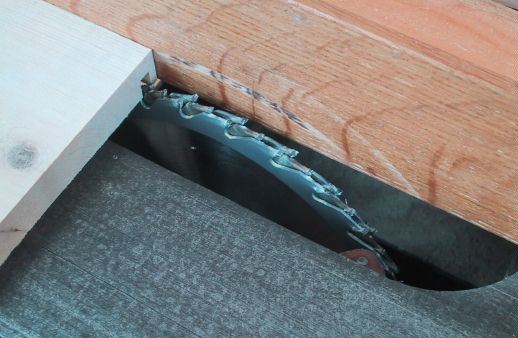Cheap dado blade substitute
A Dado set would be nice to have sometimes. Looking at buying one, I was shocked to find that these things go for well over $100 canadian at the Home Depot. Even though I could well afford that kind of expense, I didn't think I'd use it enough to justify the expense. And besides, how dare they charge that much when they also sell carbide tipped 7.5" skillsaw blades for $7 Canaidan.Thinking about it some more, what I'd done up to that point is to just make a series of cuts, moving the fence by a couple milimeters each time, until I got a cut of the desired width. If only my sawblade was a little wider, this would go so much faster. Then it occured to me that I might put two sawblades in my saw side by side, and then, why stop at two...
So I bought three of those cheap saw blades. The teeth on these blades are quite a bit wider than the actual blade itself, so its necessary to put them at a slightly different rotation, so that the teeth go into the open space on the blade next to it. Putting three side by side, the sides from the teeth on the outside will barely not hit each other with a blade in between.
To get extra width, its possible to put shims between the blades, up to nearly a milimeter before the blades leave a piece of wood in between. This way, you can do fine adjustments for how wide your cut will be. A variety of materials work good enough for shims - I prefer sheets of plastic, mostly from packaging. Cardboard also works, although the edges can fray and then you can't rely on them to be completely flat anymore. Or you can order a set of dado shims from Lee Valley Tools.

A dado by stacking cheap 7 1/2" saw blades
Finally, I wouldn't recommend stacking more than 4 blades at once. If you need a wider cut, just make successive cuts.
Also, when you go to buy the blades, take a caliper with you, and make sure they all are the same radius. I found that one of the three blades I bought had a radius that was 0.5 mm smaller than the others. It was a good blade, just with all the teeth ground slightly smaller - very annoying that way. Another old blade I had lying around was just the right size and number of teeth, so I just use that one now.
People have commented...
Every once in a while, this idea is discussed in various online woodworking forums. Two concerns keep coming up consistenly:This will plug up with sawdust
-
Blades stacked like that don't leave a lot of room for sawdust chips to be
carried away, so surely this will get plugged up quickly.
I was worried about this when I first tried it too, but the best way to find out is to try it. As it turns out, chip removal has never been a problem. I think mostly because with a dado, one generally doesn't cut as deep and as fast as one would with a regular saw blade.
Safety
-
Well, this one's subjective, and hard to argue. When I use a real dado, I'm
always a little queasy about stacking them on the arbour. The shape of the dado
chip removers is not that confidence inspiring. I'm more comfortable stacking
sawblades than dado chip removers. But if you think this is unsafe,
you probably shouldn't be using dado blades either. But really, this one's subjective.
Some people are less comfortable trying things out than others.
To my Woodworking website
or the Woodworking tools & Techniques index.
To Matthias Wandel's Home page